42 Million Americans At Risk: Food Stamps Threatened November 1: Your Survival Toolkit
Depression-era recipes, free food resources, and the bartering strategies that can keep families fed right now.
The Height of the Great Depression.
It was 1931.
A woman stood at her stove, staring into a pot of boiling water. On the counter was a can of tomatoes, a handful of macaroni, and the end of a sausage she’d traded a neighbor two eggs for. She stirred slowly, adding corn and a pinch of salt. It wasn’t much but when it came together, it became something larger than the sum of its scraps.
They called it Hoover Stew.
It became a staple of survival and shared across millions of kitchen tables during the Great Depression. Every spoonful carried a different story from community members who learned that hunger was best faced together.
Down the block, the smell of bread and stew drifted from a communal kitchen. Women lined up at dawn to cook with whatever the city or church could gather such as flour, donated beans and bruised vegetables.
In Chicago, those municipal kitchens were feeding thousands of people a day by 1932.
They called it making do, and what they were really doing was holding each other up by supporting their communities.
Nearly a century later, another kitchen grows quiet.
The U.S. Department of Agriculture has warned that SNAP benefits, the food aid that helps one in eight Americans eat, may stop going out starting November 1st, 2025, if the government shutdown continues.
That means millions of families will start to wake up to empty cupboards as the weeks pass, just as those families did in 1931.
The Great Depression taught us:
When the system fails, community doesn’t.
When money disappears, ingenuity doesn’t.
And that when the cupboard runs bare, neighbors will still show up for one another.
In a grocery store outside Pittsburgh, a 66-year-old widow might stand for many minutes in front of the bread aisle. Not shopping, just staring, doing the calculations in her head. How long will this milk last? Which bill could wait?
Her household depends on the $291 a month in food assistance her disabled nephew receives through SNAP. That money is about to disappear.
She shared with a reporter she fears losing heat this winter and any hope of celebrating Thanksgiving.
She’s one of 42 million Americans whose November benefits hang in the balance after the USDA confirmed it would not draw from its $5 billion emergency reserve to fund the program during the shutdown.
Like in 1931, we have a choice:
Do we face this alone or do we come together to lift our communities when the government fails us.
What’s Happening to Our Food Stamps
The federal government shutdown that began October 1 2025 has entered its fourth week. On October 10, the USDA warned that if the shutdown continues, there will be insufficient funds to pay full November SNAP benefits for approximately 42 million Americans.
Let me make this crystal clear:
One in eight Americans depends on SNAP.
The average benefit is about $188 per person per month, roughly $6 per day.
About 42 million people may not receive their full November benefits unless the shutdown ends.
Multiple states have already issued alerts: Benefits will not be paid until the shutdown ends.
October benefits: Already distributed.
November benefits: Delayed or suspended in most states.
Your EBT card: Any remaining October balance can still be used (for now).
Back-payments: If benefits are delayed, they’ll be paid once funding is restored.
Food or Bills
For many households, SNAP is what they rely on to stay fed.
For decades, food stamps have acted as one of our quiet stabilizers, expanding when times get hard and contracting when recovery begins. They were created in 1939 to move surplus food from farms to families, and over the generations have become one of the most effective anti-hunger tools the government has ever built.
Every $1 in SNAP benefits generates roughly $1.50-1.80 in economic activity, keeping local grocery stores open and rural farmers afloat. When that flow of money stops, communities begin to starve.
Here’s the reality hitting families right now:
Nearly 8 in 10 SNAP households include a child, the elderly, or a person with a disability.
In many households, about 80 % of benefits are used by the second week of the month.
Food pantries are already overwhelmed and cannot make up for what SNAP may leave behind.
The CEO of Hunger Free America and a former USDA official, warned that the shutdown could cause “the greatest hunger catastrophe in America since the Great Depression.”
Now is the time to remember what our grandparents knew about survival.
The Emergency Toolkit: Resources You Can Use TODAY
If your benefits are delayed or suspended, you are not alone.
Here are verified national resources that can connect you to food, assistance, and local support.
Bookmark, share, and print this if you need to.
IMMEDIATE FOOD ASSISTANCE
📞 National Hunger Hotline
1-866-3-HUNGRY (1-866-348-6479)
1-877-8-HAMBRE (for Spanish)
🕐 7am-10pm Monday-Friday | Hours vary for different communities
✅ Connects you directly with food banks, pantries, and federal nutrition programs.
Operated by Hunger Free America in partnership with the USDA.
Official USDA page
📞 Dial 211 (Community Services)
Call 211 from any phone (or visit 211.org)
🕐 Available 24/7 | Free and Confidential
✅ Provides help in multiple languages with:
• Food and nutrition assistance
• Utility and rent support
• Healthcare, childcare, and mental-health resources
Operated by United Way Worldwide and local community agencies.
Feeding America Food Bank Locator
www.feedingamerica.org/find-your-local-foodbank
✅ Enter your ZIP code to find your nearest food bank or pantry.
✅ Lists hours and local programs offering free groceries or hot meals.
✅ Most locations require no documentation or ID.
📚 Feeding America is the largest domestic hunger-relief network in the U.S.
FindHelp.org
www.findhelp.org
✅ Search by ZIP code for free food, rent assistance, utility help, and emergency support.
✅ Includes verified listings for thousands of local nonprofits and programs.
📚 FindHelp (formerly Aunt Bertha) partners with major hospitals and community service organizations nationwide.
FINANCIAL ASSISTANCE PROGRAMS
WIC (Women, Infants, and Children)
✓ For pregnant women, new mothers, and children under 5
✓ Provides food assistance and health care referrals
✓ No immigration status requirement in most states
🌐 www.fns.usda.gov/wic - Find your state agency
School Meal Programs
✓ Free/Reduced School Breakfast & Lunch: Apply through your child’s school
✓ Summer Food Service Program: Free meals for kids 18 and younger
🌐 www.fns.usda.gov/meals4kids
Senior Food Programs
✓ Many food banks host senior programs with free groceries
✓ No income verification required
✓ Contact your local food bank to find programs near you
BenefitsCheckUp.org
🌐 www.benefitscheckup.org
✓ Free service from National Council on Aging
✓ Personalized report of programs you may qualify for
✓ Help with medications, healthcare, utilities, and more
Lessons from the Great Depression
Our grandparents survived on almost nothing.
They understood that security could vanish overnight, but community could not. When the economy collapsed, they learned to measure worth in resourcefulness like how long a sack of flour could last, how many ways a chicken could feed a family, how to turn what was left into what was needed.
The “Gathering Fragments” Way
During the Great Depression, families lived by one rule:
Nothing is waste if you’re creative enough.
Across America, kitchen tables became classrooms in resourcefulness. What couldn’t be bought was borrowed, traded, or reinvented.
Stale bread became bread pudding, breadcrumbs, or croutons
Vegetable scraps turned into soup stock or stew base
One chicken fed a family for a week by being roasted the first night, soup from bones, eggs if it stayed alive
Potato peelings were fried crisp as snacks
Worn-out clothes became quilts, braided rugs, or cleaning rags
How to “Gather Fragments” Today
History repeats itself and occasionally offers instructions.
These Depression-tested habits still work:
Freeze vegetable scraps (onion ends, carrot tops, celery leaves) in a bag- when full, boil into homemade broth
Save bacon grease for cooking, people once called it liquid gold
Turn leftover rice into fried rice, rice pudding, or hearty soup filler
Overripe bananas: Freeze for smoothies or mash into banana bread
Chicken bones: Simmer overnight for bone broth that stretches across meals
Each act of reuse is small, but small is what saved families then, and it’s what will help us now. Small actions add up over time.
The Bartering System
Money disappeared during the Depression.
So communities created their own economy.
What they did as a community to support each other:
Traded eggs for vegetables
Exchanged sewing services for firewood
Swapped childcare for home repairs
Created tool-sharing cooperatives
Formed “sewing circles” where skills were traded
How you can do this now:
Create a neighborhood or social media group in your area for bartering:
“I’ll watch your kids if you fix my car”
“I’ll bake bread if you share garden vegetables”
“I’ll help with homework if you help with computer issues”
Share bulk purchases: split a Costco membership and divide goods
Tool lending libraries: why own 10 lawnmowers on one street?
The Multi-Generational Household
Families moved in together to help save them.
Grandparents, aunts, uncles, cousins all under one roof
Shared rent, utilities, childcare, cooking
Multiple income streams pooled together
Shared knowledge and skills across generations
How you can do this now:
Consider taking in a relative who’s struggling
If you have a spare room, rent it to someone you trust
Split housing costs with friends (intentional community living)
Share childcare duties with neighbors or family
Create meal-sharing agreements with neighbors (you cook Monday/Wednesday, they cook Tuesday/Thursday)
Modern Survival Strategies: Creative Ways to Feed Your Family
Combining Depression-era wisdom with modern resources:
At the Food Pantry
First time visiting? Here’s what to expect:
✓ Friendly volunteers are there to help with no judgment
✓ They may ask about family size (just answer honestly)
✓ You don’t need to explain why you’re there
✓ Many pantries let you choose your own items
Pro tips:
Call ahead to confirm hours and what they need
Ask about delivery services (many offer this for seniors/disabled)
Inquire about pet food programs
Many also provide diapers, formula, personal care items
Some pantries offer fresh produce on specific days
Don’t skip this! Food banks can provide over $5 worth of food for every $1 donated.
Stretching Every Dollar at the Grocery Store
Never shop hungry You’ll spend 30% more
Shop the perimeter That’s where whole foods are
Compare unit prices Not total prices (price per ounce)
Store brands are often made in the same factories as name brands
Frozen vegetables are just as nutritious as fresh vegetables and won’t spoil
Manager’s specials on meat/bread near expiration, buy and freeze immediately
Eggs are the cheapest protein About 41 cents per egg
Dried beans and rice cost pennies per serving and are complete proteins together
The Most Budget-Friendly Foods (Depression Era Favorites That Still Work):
Oats: Bulk oats average about $1.50-2.00 per pound and make roughly 40 servings of oatmeal.
Potatoes: Around $1.00 per pound on average and are incredibly filling and versatile.
Dried Beans: About $1.60-2.00 per pound dried, = 6 pounds cooked = 24 servings.
Eggs: Roughly $4.95 per dozen ($0.41 each) still one of the cheapest complete proteins.
Peanut Butter: High in protein, calorie-dense, and long-lasting.
Cabbage: About $0.70 per pound and works in coleslaw, soups, stir-fries, or fermented as sauerkraut.
Pasta: Around $1.20 per pound, making about 8 servings.
Canned Tomatoes: About $1.30 per can; a base for stews, sauces, and soups.
Store Strategies:
Discount & Dollar Stores:
Great for canned goods, pasta, rice, and spices. (Dollar Tree, Family Dollar, Dollar General, or regional discount markets.)Low-Cost Grocery Chains:
If you’re near Aldi, WinCo, Food 4 Less, Grocery Outlet, or regional stores like Save-A-Lot, Price Rite, or Market Basket, compare weekly flyers since they often beat national chains on staples.Warehouse & Bulk Options:
Split a Costco, Sam’s Club, or BJ’s membership with friends or family and divide bulk goods to reduce waste and cost.Ethnic & Independent Markets:
Asian, Hispanic, Middle Eastern, and African grocers frequently sell rice, beans, lentils, spices, and produce for less. These stores are often small family businesses that price for their local communities.Farmers Markets & Farm Stands:
Visit near closing time as vendors often lower prices rather than haul produce home. In rural areas, check farm co-ops or CSA (Community Supported Agriculture) boxes for fresh, local deals.Day-Old Bakeries & Discount Bread Stores:
Many national bakeries (like Franz, Bimbo, Pepperidge Farm) have outlet stores selling bread at half price. Bread freezes perfectly so buy extra and store for later.Community & Food-Share Networks:
Look for food co-ops, Buy Nothing groups, or local Facebook marketplace swaps. These are modern versions of Depression-era trading circles where excess produce, pantry goods, or services are exchanged freely.
Making Food Last: Depression-Era Preservation Techniques
When cupboards were bare during the Great Depression, families learned to make food last through attention. Those same methods still work today, and they can stretch your budget more than a coupon.
Immediate Actions
Freeze bread as soon as you get home thaw slices as needed to prevent mold.
Freeze milk Shake well after thawing for best texture.
Freeze cheese before it molds Texture changes slightly but works perfectly in cooked dishes.
Wash and freeze berries on a baking sheet before bagging and they’ll stay separate instead of clumping.
Blanch and freeze vegetables when they’re on sale or in season they’ll last months and retain nutrients.
Stretch Strategies
Double recipes and freeze half. Same effort with twice the meals.
Stretch ground meat with lentils, rice, or diced potatoes. High in fiber, lower in cost.
Turn everything into soup. Any vegetables, leftover meat, or grains simmered with broth becomes dinner.
Breakfast for dinner. Eggs, oatmeal, or pancakes are nutritious and cost pennies.
A Few Recipes That Saved Families
These simple, filling recipes helped families get by in the 1930s and many still cost well under $2 per serving in terms of bulk or staple ingredients. The exact cost can vary by region and grocery store, so treat the numbers below as approximate budget-references rather than guarantees for 2025 prices.
1️⃣ Hoover Stew (Serves 6 – Total Cost Around $5)
1 pound pasta ($1)
1 can tomatoes ($1)
4 hot dogs, sliced ($2) or any leftover meat
Any vegetables you have
Water or broth
Cook pasta, add everything else, simmer 10 minutes. Complete!
Named for President Hoover, this dish was served in Depression-era “Hoovervilles” improvised soup kitchens that fed thousands.
2️⃣ Potato Soup (Serves 8 – Total Cost Around $4)
6 potatoes, diced ($2)
1 onion ($0.50)
2 cups milk ($1)
Butter or oil ($0.50)
Salt and pepper
Boil potatoes with onion until soft. Mash some for thickness, add milk and butter, season, and simmer.
3️⃣ Beans & Rice (Serves 10 – Total Cost Around $3)
2 cups dried beans ($1) or 4 cans
2 cups rice ($1)
Onion and garlic ($1)
Spices you have
Cook beans and rice separately, then combine with sautéed onion and garlic. Together, they form a complete protein: simple, healthy, and adaptable.
4️⃣ Depression Bread (2 loaves Total Cost Around $2)
6 cups flour ($1)
2 tablespoons yeast ($0.50)
2 tablespoons sugar ($0.10)
2 teaspoons salt ($0.05)
Warm water (free)
Mix, let rise, and bake. Two loaves can feed a family for several days — the smell alone feels like security.
5️⃣ “Anything Goes” Casserole (Serves 6 – Cost Varies)
Base: leftover pasta, rice, or potatoes
Protein: any meat, beans, or eggs
Vegetables: fresh, frozen, or canned
Sauce: 1 can cream of mushroom soup ($1) or homemade white sauce (butter + flour + milk)
Topping: breadcrumbs or crushed crackers
Layer, bake at 350 °F for 30 minutes, and serve.
The taste changes every time, that’s one of the beauties of it.
The Forgotten Skills That Save Money
Skills worth relearning:
Make broth from scraps. Save vegetable ends and bones in the freezer; simmer later for stock and saves about $4 every time you’d buy a carton.
Bake your own bread. Flour, yeast, and time, a $2 loaf costs $0.50 to make.
Patch and mend clothes. Keeps $20–50 in your pocket for every item you don’t replace.
Regrow vegetables. Green onions, celery, lettuce, and garlic can all regrow from kitchen scraps.
DIY cleaning supplies. Vinegar, baking soda, and lemon juice replace most commercial cleaners and can save you up to $50 a year.
Learning tools: YouTube, your local library, and cooperative extension classes often teach these skills free of charge.
Try learning one new skill per month, small knowledge adds up fast.
Lesser-Known Survival Strategies
Modern convenience has made us forget how flexible a kitchen can be. Here are practical, real-world ways to stretch what you have.
Get Creative with Proteins
Eggs + Toast: A balanced, filling meal for under $0.60.
Peanut butter: Works on bread, apples, crackers, or stirred into oatmeal.
Canned tuna or salmon: Mix with mayo for sandwiches, or add to pasta or rice.
Rotisserie chickens: Often cheaper than raw chicken and you can use every part, from meat to bones for broth.
Hidden Food Resources
Church & Community Pantries: Open to anyone, no membership required.
Sikh Temples (Gurdwaras): Offer free vegetarian meals to everyone, no questions asked.
School “Backpack Programs”: Many schools discreetly send food home with children in need, ask your counselor.
Community Fridges: Free, shared refrigerators stocked by neighbors with no paperwork or judgment. For more information on how you can start a community fridge, click here and scroll to the end for the section on starting a Community Fridge.
“Ugly Produce” Services: Companies like Misfits Market and Imperfect Foods deliver low-cost, imperfect fruits and vegetables.
Food Rescue Apps: Apps like Too Good To Go or Flashfood sell restaurant and grocery surplus for 50–80% off.
Gleaning Programs: Many states let volunteers harvest leftover crops from farms for free produce.
If you’re struggling, you’re not alone and these programs exist because hunger is a systemic failure, not a personal one.
Meal Stretching Tricks
Add water or broth to canned soup to double the servings.
Oatmeal expands fourfold. ¼ cup dry makes 1 cup cooked.
Pasta doubles or triples in volume when cooked.
Add cabbage to your meals, it’s about $0.50 per pound, filling, and full of nutrients.
Make smoothies from overripe fruit, oats, and water: Affordable, healthy, and zero waste.
Free or Nearly Free Food Sources
Food Rescue Apps: Too Good To Go, Flashfood, and Olio connect you with discounted or free surplus food.
Community Gardens: Many share produce with anyone who helps plant or harvest.
Gleaning Networks: Farmers often allow volunteers to pick remaining crops after harvest.
Foraging (Learn Safely): Dandelion greens, wild garlic, berries. Nature still feeds those who know what to look for.
(Always check local regulations and safety guides before foraging.)⚠️ Dumpster Diving is technically legal in many states but safety and local ordinances vary per state and community. Always prioritize your health and safety
For Those Who Can Help
You might be thinking: “I’m not affected, but I want to help.”
1. Donate Money, Not Just Food
Food banks can purchase significantly more food with cash donations due to bulk purchasing power. A $20 donation to your local food bank can purchase up to $140 worth of food at grocery store prices.
Where to donate:
Your local food bank
Directly to food pantries in your area
Mutual aid groups (search “mutual aid near me” on search engines like Google)
2. Volunteer Your Time
Food banks desperately need:
Sorting and packing food (2-3 hours makes a big difference)
Picking up donations from stores
Delivering food to seniors
Staffing distribution events
Sign up: Contact your local food bank or visit www.feedingamerica.org
3. Check on Your Neighbors
Especially if they are:
Elderly neighbors living alone
Single parents
People with disabilities
Veterans
Families with young children
A simple text: “Hey, I’m going to the store, need anything?” can be lifesaving.
4. Create a Neighborhood Food Swap
Start a community group online or use other app chats
Share from gardens
Coordinate meal-sharing
Set up a “little free pantry” box in your front yard
5. Support Local Farms
Buy a “double share” CSA box (one for you, donate one)
Ask farmers if they’ll let you glean (pick leftovers)
Connect farmers with food banks
COMMENT BELOW:
What creative tip or lesser-known resource has helped you (or someone you know) survive when money was tight?
Maybe it’s:
A recipe that can feed a family
A local organization that helped you
A skill you learned that saved you money
Your experience could save someone else’s life.
Drop it in the comments so we can build the a comprehensive survival guide together.
No one can predict when the shutdown will end or when benefits will resume.
But we can control how we respond and how we can show up for our communities.
If you need help:
Use and share resources in this guide
Visit a food pantry (there is ZERO shame)
Call 211
Ask for help: That takes more courage than suffering alone.
If you can help:
Commit to ONE of these to help:
Donate $10, volunteer once, check on one neighbor
Share this post to get resources to people who need it
Add resources or food savings tip/trick in the comments
If you’re reading this and feeling embarrassed that you might need help:
Stop.There is no shame in feeding your family.
There is no shame in accepting help.
There is no shame in survival.



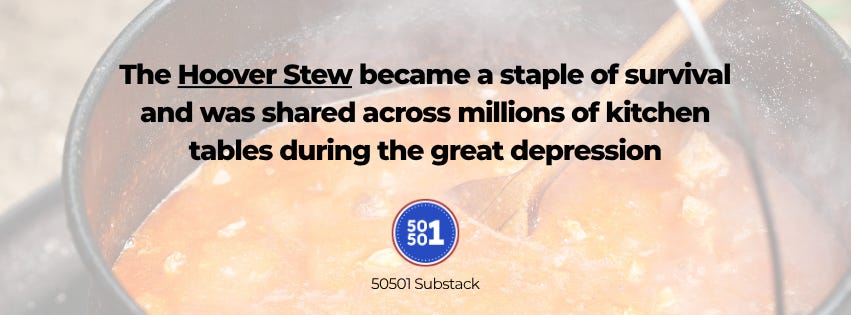
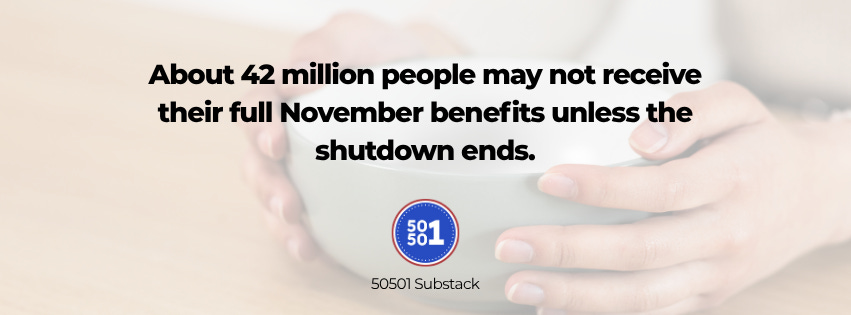
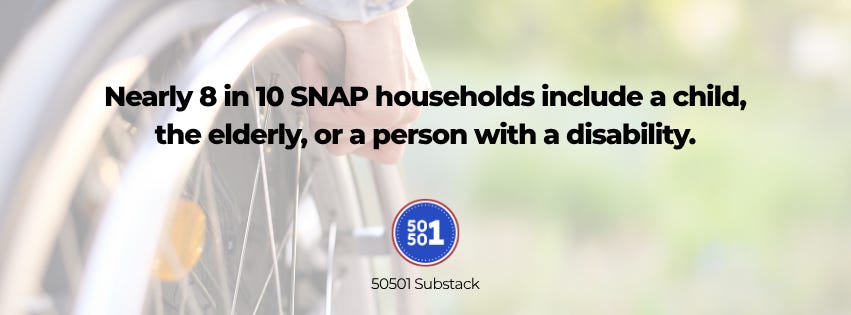

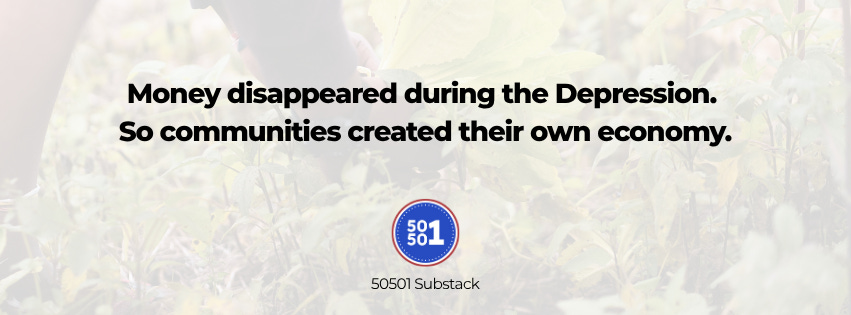
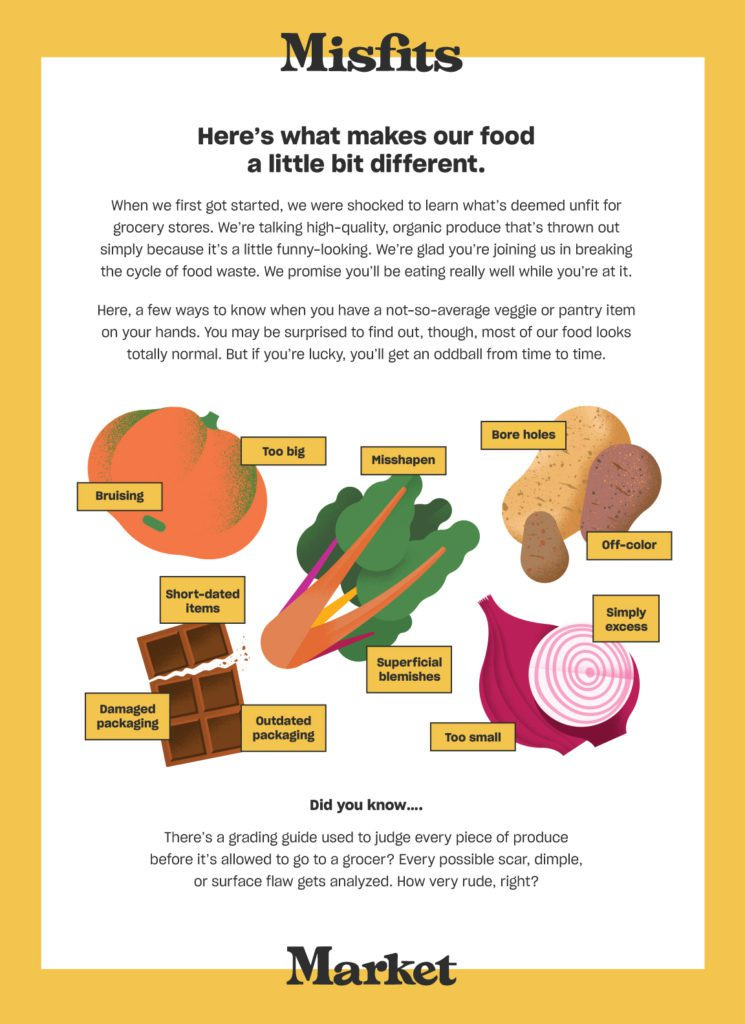
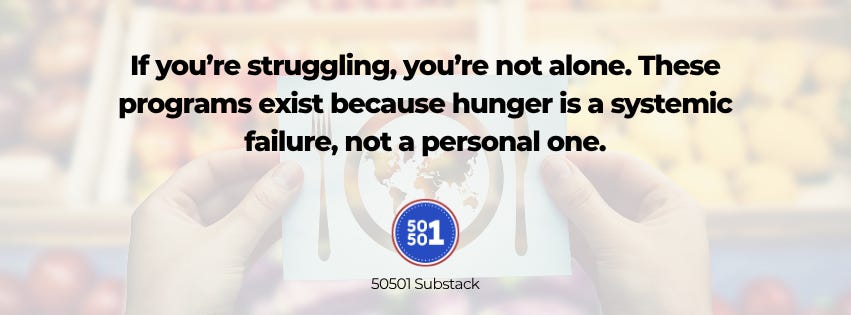



This is absolutely critical information right now, and going forward as we will be losing SNAP benefits anyways. *Let them eat cake* Okay, so we can feed each other when the going gets tough. Thank you for assembling this.
This is so wonderful to see. Hooverville food from the Great Depression. Who in the MAGA klan thought their president would do this to them? He promised lower prices for everything from groceries to energy to petrol! Now they are seeing with their own eyes that he was lying to them the entire time. He has been made a billionaire several times over with his Ponzi schemes selling crypto without even buying it! His World Liberty Financial is just the "middleman" tethered to Binance, who's CEO he just pardoned so they can carry on with their schemes. They trusted this man to save them from democracy's "woke-ness," he's leaving them without a potato to eat! I'm sorry this is happening but I must warn you it's not yet as bad as it's going to get. His super-rich pals are going to be making so much money too because they are going o cut your wages if you even have a job. Even the lowest paid worker will not be able to argue as he has taken that right away from you as well. The redistricting can solve some of the issues with the voting he's gerry mandering but not all. You need to be prepared fight for even this right. Don't lose hope. There are people in the USA like THE 50501 MOVEMENT that are working for you everyday. Give your time and any money you can spare to help them help others. Don't go out with a whimper. Don't let the oligarchs run America. It's still YOUR land! This is not the end of the line for you but it should be for him and his GOP (Guardians Of Pedophiles)